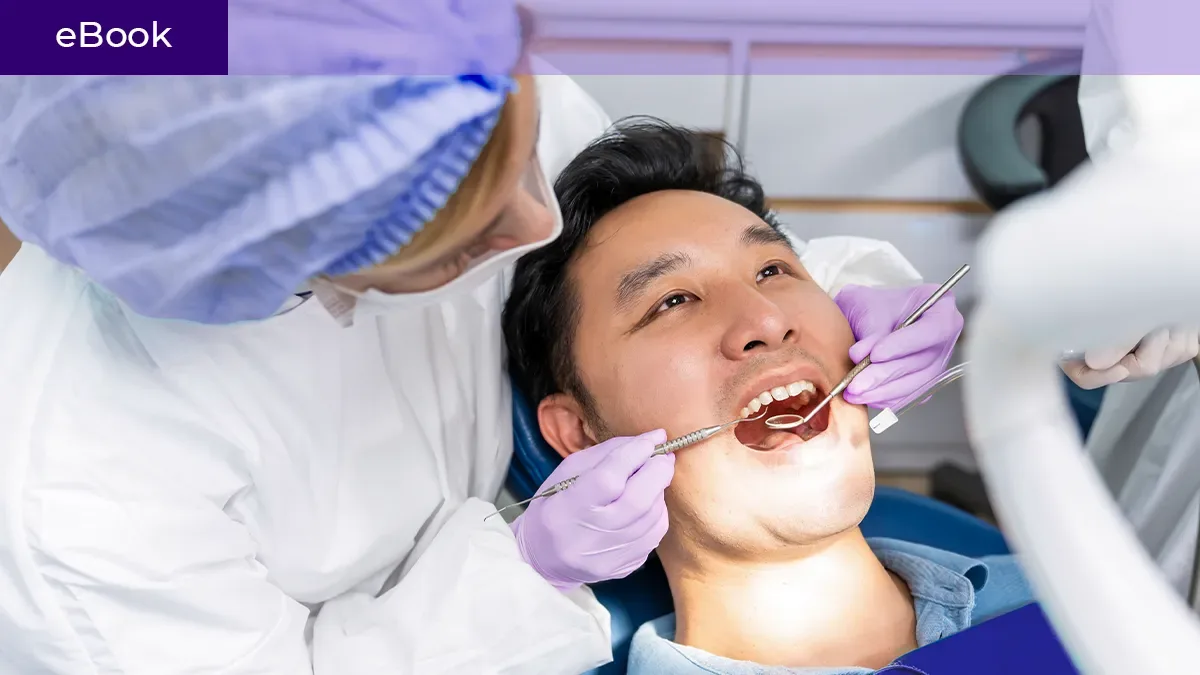Navigating dental claim FWA: The impact of abused codes and claim splitting
Steven M. Canfield, DDS | Shea Boone, CDC

The landscape of dental claims is fraught with complexities, where the misuse of specific dental codes and improper billing practices have become more prominent. From bone grafts to buildups, scaling, and root planing, improper billing and overuse of these codes for patients where such treatment is deemed unnecessary can negatively impact patient health and stimulate mistrust between payers and providers.
Among these payment schemes, overbilling and claim splitting have become common fraudulent practices that impact the integrity of dental payments. In 2023, dental expenditures reached $174 billion, accounting for more than 3% of total healthcare spending. As the dental industry continues to grow and evolve, these schemes can become difficult to identify, resulting in improper billing practices which drive up costs.
In this eBook, we highlight the top procedures that are frequently misused and offer insight into these trends by examining their causes, consequences, and the steps necessary to mitigate the effects of fraudulent and abusive dental billing practices. By understanding the nuances of these schemes, dental payers can foster a more ethical and efficient claims process, ensuring transparency for all stakeholders.
Commonly abused codes and their impact
Abusive billing practices often revolve around the misuse of certain dental procedure codes. These codes, when improperly applied, can result in inflated costs and undermine the integrity of the dental claims process. Some of the most commonly abused codes include bone grafts, non-surgical root canal obstructions, buildup, localized antimicrobial agents, and surgical extractions.
Bone grafts
In 2024, Cotiviti dental clients were billed $14.7 million for bone grafts, a procedure often added to extractions without medical necessity. Following clinical review of the documentation, our experts revealed a savings of nearly $3 million, approximately 20% of the total billed amount by identifying and addressing improper billing for bone grafts.
Root canal treatments
The code D3331, used for treating root canal obstruction, is frequently billed alongside routine root canal treatments (RCTs) without sufficient evidence of an obstruction. In 2024, clients were billed $2.9 million under this code. After reviews, approximately 18.7% or $543,000 in improper charges were identified and saved.
Buildups
Buildups under crowns are another area prone to overbilling where providers must demonstrate that there was insufficient retention in a crown, which necessitates the need for an extra coronal restorative procedure. If documentation fails to demonstrate the necessity for a buildup procedure, clinical review can flag the claim. In 2024, clients were billed $52.8 million for buildups, with $8.4 million in improper charges identified and prevented—representing a savings rate of approximately 15.9%.
Gingivectomies and localized antimicrobial agents
Codes like D4381 pertain to the localized delivery of antimicrobial agents via a controlled release vehicle into diseased crevicular tissue. This code is used for each individual tooth when an FDA-approved antimicrobial agent is sub-gingivally placed into periodontal pockets of at least 5mm depth. In 2024, clients were billed $3 million for procedure code D4381. Clinical reviews ensured billing aligned with treatment guidelines, resulting in $208,000 in savings—reflecting a savings rate of approximately 6.9%.
Extractions
In 2024, procedure code D7210, associated with the surgical extraction of an erupted tooth, was billed at $121 million. Clinical reviews reclassified many of these cases to D7140, a less intensive procedure, resulting in $37.4 million in savings for clients, representing a savings rate of approximately 30.9%.
Scaling and root planing
Historically, scaling (D4341) and root planing (D4342) are highly abused codes. Over a three-year period from 2019 to 2022, Cotiviti clients were billed over $16 million for scaling and root planing (SRP). After reviewing the providers submitted records and verbiage for what constitutes the necessary requirements for the procedure, our clinical experts denied or suggested a re-code. This review saved our clients an average of 39% of their total dental spend for SRP.
In total, expert review of commonly abused and overused codes resulted in over $55 million in savings for Cotiviti clients. These examples reveal the widespread financial impacts of abusive billing practices, underscoring the need for vigilance and robust review processes.
Claim splitting trends
Claim splitting occurs when dental providers separate a single claim into multiple submissions. While this can be legitimate for administrative reasons, it is often misused to manipulate reimbursement by dividing procedures typically performed in one visit into separate claims. This can be done by using different dates of service, billing lines, or provider identification. Improper claim splitting is used to bypass reimbursement limitations, inflate payments, or obscure the true nature of services. Understanding this practice is important to help ensure payment integrity for both dental providers and insurers.
Some common patterns and their implications include:
- Multiple Extractions: Claims for multiple extractions on the same date of service are split into separate submissions to avoid rules that apply to four or more extractions.
- X-Rays and Root Canals: X-rays are submitted on a separate claim line from the root canal procedure to bypass review.
- Prophylaxis (D1110) and periodontal maintenance (D4910): These are often billed on the same date of service but under separate claims.
Proper claim splitting can benefit a patient with dual coverage or reflect true dates of service for treatment provided over multiple appointments. But often, this process is misused, leading to overpayments and obscuring the necessity of services. This can increase the risk of investigations, audits, or fraud allegations, and further complicate the dental claims landscape.
Key recommendations
Prevention of abusive billing requires a proactive approach rooted in education, review, and system improvements. Dental payers can take actionable steps to help mitigate these practices.
Implement robust utilization reviews. Regular and thorough reviews of claims can identify patterns of abuse. For example, monitoring high-frequency use of specific codes like D3331 and D7210 can flag improper billing.
Enforce clear documentation requirements. Require dental providers to submit comprehensive documentation that justifies the procedures billed. For instance, buildups should only be reimbursed when evidence shows insufficient retention for an extracoronal restorative procedure.
Educate providers. Provide training and resources to dental providers on proper billing practices, including clear explanations of coding guidelines and payer policies.
Leverage advanced analytics. Utilize data-driven solutions to identify trends and anomalies in claims submissions. Advanced analytics can detect patterns like improper claim splitting or repeated overuse of certain codes.
Collaborate with providers. Work collaboratively with dental offices to establish clear communication channels and resolve billing discrepancies amicably.
Monitor claim splitting practices. Develop systems to track and analyze claim splitting patterns, ensuring they align with administrative and medical necessity guidelines.
Abusive billing practices not only inflate costs but also erode trust between dental providers and payers. By addressing trends in overbilling and claim splitting through systematic reviews, education, and collaboration, dental payers improve payment integrity and help alleviate provider abrasion. Adopting these measures not only protects financial resources but also ensures a fair and transparent claims environment, ultimately benefiting both providers and patients.
The Cotiviti approach to dental accuracy
Fully accredited by URAC for Health Utilization Management, Cotiviti’s Dental Claim Accuracy is an all-in-one, prepay SaaS solution that bundles provider-enhanced review, code editing, pre-authorization, and professional review capabilities for total cost containment. Powered by highly customizable rules and analytics engine, Dental Claim Accuracy enables dental plans to identify and clinically validate suspect claims before they are paid.
Cotiviti’s comprehensive dental policy library is researched and reviewed by internal experts with clinical experience, allowing flagged claims to receive comprehensive review that is cross-referenced with clinical data and guidelines to ensure that the treatment billed is necessary and appropriate. With over 25 years of payment accuracy experience, Cotiviti helps drive exceptional value with proven results. Plans have the potential to save an average of 3% or more on their annual dental spend by using Dental Claim Accuracy.
Start the conversation with Cotiviti
Learn more about how we can help you advance your dental payment integrity operations by setting up an exploratory call with our team.
About the authors
|
|
Steven M. Canfield, DDS Dr. Canfield works with Cotiviti’s prepayment leadership team and has been responsible for Dental Claim Accuracy operations since 2012, including overseeing a panel of professional consultants that perform clinical claim reviews. He also works as a clinical instructor at the University of Utah School of Dentistry and operates a private practice out of Salt Lake City, Utah. Dr. Canfield attended dental school at Creighton University, and has been practicing dentistry and reviewing dental insurance claims for more than 30 years. |
 |
Shea Boone, CDC Shea has over 20 years of experience in the dental industry, specializing in dental analytics with Cotiviti for the past 16 years. She works with the prepayment leadership team, focusing on account management, client engagement, and the development of customized dental analytics solutions. |
